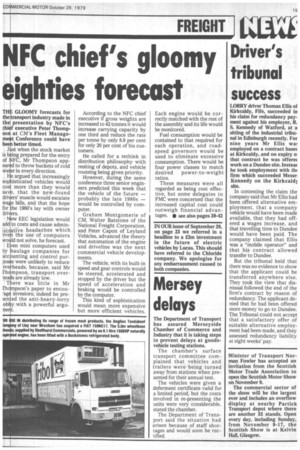FC chief's gloomy ighties forecast
Page 21

If you've noticed an error in this article please click here to report it so we can fix it.
GLOOMY forecasts for the transport industry made in th presentation by NFC.'s chi f executive Peter Thompso at CM's Fleet Manageme t Conference could have bee better timed.
J st when the stock market is b ing prepared for the entry of FC, Mr Thompson appear to throw buckets of cold wa 'n fl every direction.
e argued that increasingly sop isticated vehicles would cos more than they would sa , that the new-found dri -rs' muscle would escalate wa e bills, and that the hope for he 1980's lay with owner dri w EEC legislation would add to costs and cause admin St headaches which eve the use of computers wo Id not solve, he forecast.
E en mini computers used by haulage companies for acc unting and control purbos s were unlikely to reduce we heads, because, said Mr rh mpson, transport over!lea s are already low.
T ere was little in Mr pson's paper to encou-ag investors; indeed he pre;en ed the anti-heavy-lorry ob y with a powerful argu-ne t. According to the NFC chief executive if gross weights are increased to 42 tonnes it would increase carrying capacity by one third and reduce the rate per tonne by only 8.8 per cent for only 20 per cent of his customers.
He called for a rethink in distribution philosophy with resiting of depots, and vehicle routeing being given priority.
However, during the same conference three senior engineers predicted this week that the vehicle of the future — probably the late 1980s — would be controlled by computer.
Graham Montgomerie of CM, Walter Batstone of the National Freight Corporation, and Peter Capon of Leyland Vehicles, advanced the theory that automation of the engine and driveline was the next commercial vehicle developments.
The vehicle, with its built-in speed and gear controls would be steered, accelerated and stopped by the driver but the speed of acceleration and braking would be controlled by the computer.
This kind of sophistication would mean more expensive but more efficient vehicles. Each engine would be correctly matched with the rest of the assembly and its life would be monitored.
Fuel consumption would be contained to that required for each operation, and roadspeed governors would be used to eliminate excessive consumption. There would be four power classes to match desired power-to-weight ratios.
These measures were all regarded as being cost effective, but some delegates to FMC were concerned that the increased capital cost could outweigh financial advantages. • see also pages 39-42
























































































































